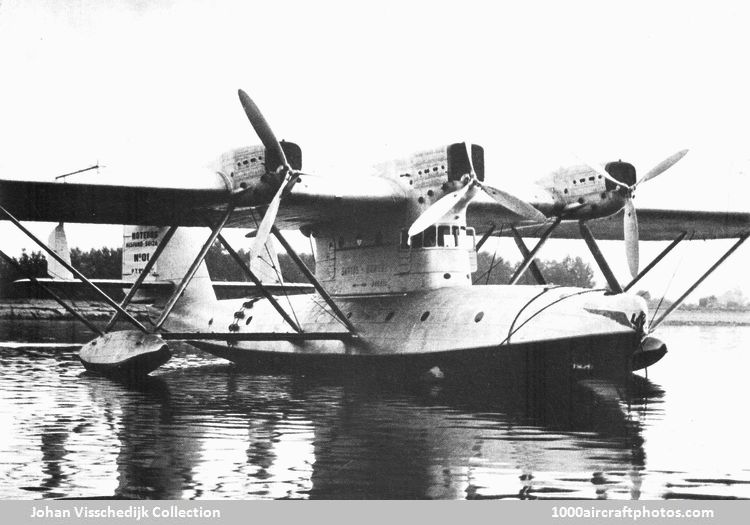The high-wing monoplane, constructed of duralumin, had a strong seaworthy hull and lateral pontoons or floats, the keel and pontoons had two steps to facilitate easier taking-off. Mounted above the hull center was the semi-circular super-structure, 13 ft 1.5 in (4 m) long, 3 ft 11.2 in (1.20 m) wide, and of a height of about 8 ft 2.4 in (2.50 m). It contained the quarters for the four men crew (a commander, two pilots and a mechanic) and radio installation, the pilot being installed in the front part of it and thus had excellent visibility.
The wings comprised a center section, forming part of the top superstructure, and to which the main wings were joined. They were braced to the hull by two steel struts mounted on each side of the super-structure. The construction consisted of two main wing spars, with the usual interior bracing. The fabric covered wings had a rectangular planform for about half their length and then taper off elliptically towards their ends. The pontoons had a volume of 106 cu.ft (3 cu.m) each, held in position by struts braced to the wing above and to the hull.
The arrangement of the four 650 hp Hispano-Suiza 12 Nbr twelve-cylinder liquid-cooled V-engines was unusual, three were placed on the leading edge of the wing, while the fourth, which drove a pusher airscrew, was situated behind the central front engine. Owing to the thickness of the wings it was possible to carry out repairs to the engines during flight. The total fuel capacity of 3,086 gal (11,684 l) was spread over 16 fuel tanks installed in the hull. The aircraft was colored aluminum all over, apart from the lower part of the fuselage and pontoons, these were rust-brown.
Lucien Bossoutrot, Blériot's Chief Test Pilot, accompanied by Filippo Zappata, made the first flight at Caudebec-en-Caux on August 3, 1933. The Seine was not an ideal test site for such a large aircraft, but Bossoutrot got the Blériot 5190 off in 17 seconds at a loaded weight of 35,718 lb (16,200 kg). It was flown without the wing tips, which brought the span up in excess of the width of the hangar. After completion the aircraft went through a series of test at Caudebec-en-Caux and Cherbourg, that took four and a half months, and were successfully completed on January 6, 1934.
On loan from the Air Ministry, the aircraft was registered to Air France as F-ANLE on November 19, 1934, and named 'Santos Dumont'. Finally in November 1934, the first commercial success was achieved when Bossoutrot flew the Blériot 5190 on its first trial mail flight from Paris to Natal via Dakar. The transatlantic Dakar to Natal section was flown on November 27, 1934, and took 16 hr and 15 min. In December another trial crossing was made, followed by nine scheduled once-a-week South Atlantic crossings between February 4 and April 1, 1935.
After a three months break it resumed the crossings in July 1935 till March 1936, when after its thirtieth crossing of the South Atlantic it was transferred to the Etang de Berre near Marseille, France, for a complete overhaul. Over a year later, April 1937, it returned to the Dakar-Natal service. After its 37th crossing in June 1937 the Blériot 5190 was withdrawn from service.
Back in 1935 the Air Ministry had ordered three additional aircraft. Already beset by financial problems with the first aircraft, Blériot had to make huge loans in order to launch the Blériot 5190 into mass production. Subsequently, in early 1936, the order was cancelled without explanation or compensation, forcing Blériot into bankruptcy. Louis Blériot died of a heart attack the following August 1."
Span: 141 ft 1 in (43.00 m)
Length: 85 ft 4 in (26.00 m)
Height: 22 ft 7.7 in (6.90 m)
Wing area: 2,390 sq.ft (222 sq.m)
Weight empty: 24,692 lb (11,200 kg)
Loaded weight: 48,500 lb (22,000 kg)
Payload: 1,329 lb (600 kg)
Max speed: 137 mph (220 kmh)
Cruise speed: 118 mph (190 kmh)
Service ceiling: 16,732 ft (5,100 m)
Range: 3,107 mls (5,000 km)
